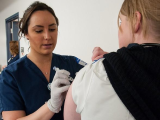Mar 2, 2009 (CIDRAP News) – In one of the largest head-to-head studies comparing two different seasonal flu vaccines in a healthy, adult population, those who received trivalent inactivated vaccine (TIV) had fewer medical visits for respiratory illnesses compared to those who received the live attenuated influenza vaccine (LAIV).
The difference between the injected TIV vaccine and the nasal-spray LAIV vaccine, however, was not as great for those who hadn't been vaccinated in the past season or two.
The study, which was posted ahead of print and will appear in the Mar 4 issue of the Journal of the American Medical Association (JAMA), was conducted in military personnel who were stationed in the United States during three flu seasons, from 2004 through 2007.
Since 2004, the Department of Defense has increased its use of LAIV—FluMist, made by MedImmune—because it is easier to use and is typically available earlier in the season, according to the report. The surveillance study was conducted to guide military vaccine policy.
For each of the three flu seasons, the investigators from the Armed Forces Surveillance Center in Silver Spring, Md., measured the incidence of healthcare visits for pneumonia and influenza-like illness among just over 1 million active-duty service members between the ages of 17 and 49 who were eligible to receive the vaccine. They used data from the Defense Medical Surveillance System, which contains demographic information, occupational history, immunization status, and medical encounters throughout each soldier's military career.
The percentage of military personnel who received LAIV rose each year from 33.5% during the 2004-05 season to 47.9% in the 2006-07 season.
Service members who had no record of immunization for each of the seasons were considered unimmunized. To reduce bias between the immunized and unimmunized groups, the researchers matched each immunized service member with an unimmunized member who had a similar age, sex, service branch, and basic medical history.
The researchers found that the unimmunized group had the highest rates of pneumonia and influenza healthcare encounters for each of the three seasons, followed by the LAIV group then the TIV group.
When the study's authors singled out hospitalizations for pneumonia and influenza, they found that rates were highest in the LAIV group for each of the three seasons, though the difference was significant from unimmunized group only during the 2004-05 season.
Results differ for vaccine-naive
However, they found that the LAIV and TIV effects were similar in vaccine-naive service members—those who had not been immunized in the previous one or two seasons.
"This suggests that preexisting vaccine-induced immunity may play a role in determining the effectiveness of LAIV," the authors wrote, suggesting that the presence of neutralizing antibodies may blunt the self-replication needed for LAIV immunization to be effective. The same factors might be able to predict a better effect for LAIV in different populations such as young recruits and children, they added.
They cautioned readers to keep in mind that the system they used to minimize bias wasn't able to eliminate important confounders such as smoking. They also wrote that vaccination status could have been recorded incorrectly in the database for some of the service members, though an assessment of anthrax vaccine data showed that the vaccine data collection was solid.
Though the findings suggest that TIV may be more effective than LAIV in a highly- immunized population such active-duty military, they warned that the results may not be generalizable to the entire US adult population.
Chris Ambrose, MD, director of medical affairs for MedImmune, the maker of FluMist, told CIDRAP News that efficacy findings in adults have been variable and that more data are needed. The idea that preexisting vaccine-based immunity may influence LAIV effectiveness in adults in their 20s and 30s is theoretical, he said.
More retrospective studies that can further limit bias between groups would be useful, he said, adding that even before the military service study was published, MedImmune had already discussed the possibility of studying the vaccine issues in a large health maintenance organization (HMO) setting. "This is an area we've agreed on," he said.
However, Ambrose said the company has no evidence that casts doubt on LAIV efficacy in children. "The pediatric data have been very consistent," he said.
Effect on recommendations unclear
In an editorial that appears in the same issue of JAMA, David M. Weinstock, MD, an oncologist from Dana-Farber Cancer Institute in Boston and Gianna Zuccotti, MD, an infectious disease specialist from Brigham and Women's Hospital in Boston, wrote that, given concerns about oseltamivir (Tamiflu) resistance in H1N1 seasonal influenza, vaccination remains the most important tool for controlling the disease.
They echoed speculation about the presence of neutralizing antibodies possibly compromising the efficacy of LAIV. "Not surprisingly, LAIV is equally or possibly more efficacious in children, who presumably lack preexisting influenza-specific immunity," they wrote.
Weinstock and Zuccotti wrote that it's unclear if the latest study comparing TIV and LAIV will affect vaccination recommendations. It may be prudent to use TIV in patients who were vaccinated at least once in the past 2 years, they said, but LAIV against pandemic strains maybe be more protective than inactivated vaccines, because the population will probably lack preexisting immunity.
Wang Z, Tobler S, Roayaei J, et al. Live attenuated or inactivated influenza vaccines and medical encounters for respiratory illnesses among US military personnel. JAMA 2009 Mar 4;301(9):945-53 [Full text]
Weinstock D, Zuccotti G. The evolution of influenza resistance and treatment. JAMA 2009 Mar 4;301(9):[Early online edition]


















